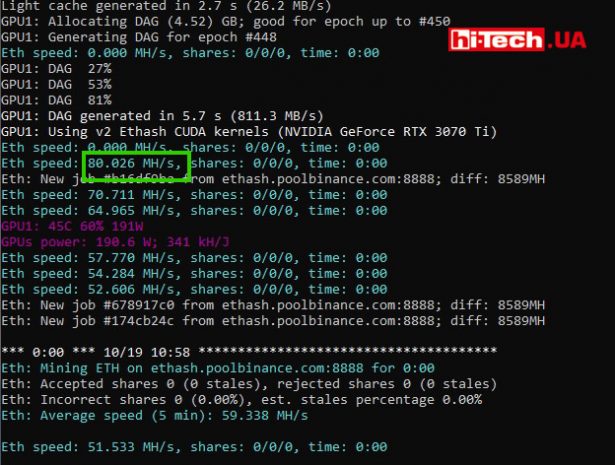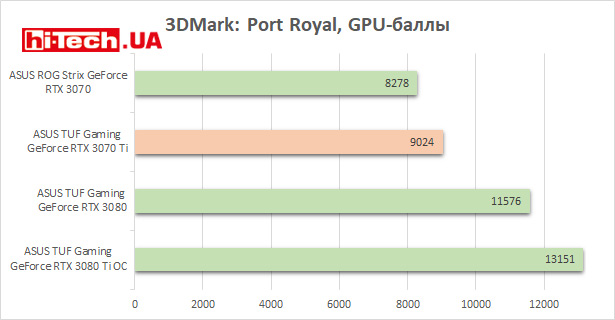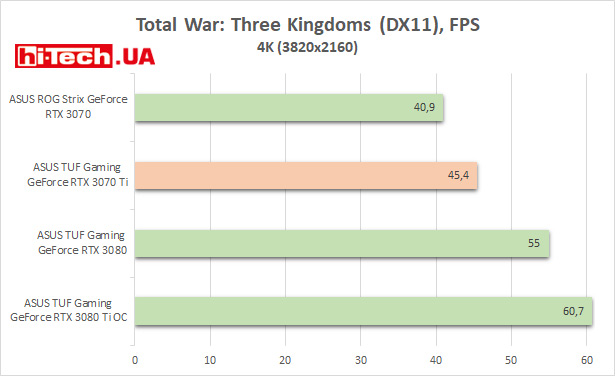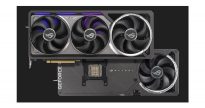ASUS TUF Gaming GeForce RTX 3070 Ti video card test. How much better than the regular RTX 3070?
22.10.21
The RTX 3080 Ti and RTX 3070 Ti video cards were released at the beginning of the summer and are more advanced versions of the RTX 3080 and RTX 3070.
The hero of our review is theASUS TUF Gaming GeForce RTX 3070 Ti video card, based, as you might guess, on the RTX 3070 Ti.
From the table above it is clearly seen that the RTX 3070 Ti differs slightly from its sister RTX 3070.
The most noticeable change was the transition to GDDR6X video memory instead of GDDR6. At the same time, the amount of video memory and the bus remained unchanged.
We also note a slight increase in the number of computational pipelines, rasterization units and RT cores.
Please note that TDP power consumption has increased quite significantly, from 220 to 290 W.
Getting to know ASUS TUF Gaming GeForce RTX 3070 Ti (TUF-RTX3070TI-8G-GAMING)
ASUS TUF series video cards of the RTX 3000 generation are quite frequent guests of our editorial staff.
Over the past year, we have reviewed such models based on RTX 3080, RTX 3060 Ti, RTX 3080 Ti.
Now we have the ASUS TUF Gaming GeForce RTX 3070 Ti (TUF-RTX3070TI-8G-GAMING).

It has similar features as other modern products in the ASUS TUF series.
Let us immediately note the very high level of external performance. And the design of the model is very good. In our opinion, it looks even better than ASUS ROG video cards, which are higher in the hierarchy.
The case “casing” on the front panel and the back plate are metal. In some places the texture of a tire imprint is noticeable on the surface. By this, the manufacturer emphasizes the endurance and reliability of ASUS TUF products.
ASUS TUF Gaming GeForce RTX 3070 Ti is quite long (30 cm), but by modern standards this is far from a record.
The manufacturer presents a case with a width of 2.7 slots as an advantage, saying that this is due to the use of a large radiator for the cooling system.
Traditionally, for the latest generation of ASUS video cards, fans have a rim along the outer radius.
The central fan spins in the opposite direction compared to its neighbors. This is intentional and is said to provide improved heat dissipation.
It’s nice that ASUS has added an additional HDMI output on the connector panel. The reference RTX 3070 Ti has only one HDMI.

Next to a pair of 8-pin power connectors there is a Performance and Quiet mode switch (implemented by switching between individual BIOS chips). This is a traditional feature of modern ASUS TUF video cards.

There are two elements with controllable RGB lighting. For some time now, ASUS has been offering quite advanced software, where you can not only synchronize components in the system and select various effects, but also create your own glow program yourself.
Cooling system
ASUS TUF Gaming GeForce RTX 3070 Ti has noticeably higher power consumption compared to the RTX 3070.
Therefore, it is not surprising thatthe manufacturer did not use the cooling system, say, from the ASUS TUF Gaming GeForce RTX 3070, but borrowed it from the older ASUS TUF models based on the RTX 3080 and RTX 3080 Ti. This gives reason to believe that the video card will have a good cooling reserve.
The SO itself is very developed. The large radiator is penetrated by a large number of heat pipes. A special heat distribution plate touches the GPU crystal. This solution is more often found on high-end video cards. More budget options usually use a solution with direct contact of heat pipes.
Another interesting detail. A separate metal frame is provided to remove heat from memory chips and some other components.
With the release of the RTX 3000 series, NVIDIA set a trend for CO design in its reference video cards, where part of the radiator is blown “through” through a window on the video card board. The same option is implemented here.
Under light loads, when the temperature drops below a certain level, the fans stop completely. This is a common feature on most graphics cards today.
The back plate also dissipates some of the heat. At some points it comes into contact with the board through thermal pads.
We check the operation: frequencies, power consumption, temperatures, noise
The frequencies of the ASUS TUF Gaming GeForce RTX 3070 Ti (TUF-RTX3070TI-8G-GAMING) fully correspond to the reference ones. There is exactly the same model with the CO prefix (TUF-RTX3070TI-O8G-GAMING), with a slight factory overclock.
The Performance and Quiet modes do not differ in frequencies.
The maximum GPU frequency depends largely on applications and games, but it is almost always higher than the declared Boost frequency. This is a common occurrence on NVIDIA graphics cards.
The maximum GPU frequency that was noticed is approximately 1950 MHz.
In the settings you can increase the energy consumption limit by 20%.
In the 3DMark Time Spy test benchmark, which loads the video card well, the power consumption of the video card was at the level of 280-290 Wwhich is quite consistent with that stated for the RTX 3070 Ti.
This is a very significant load in terms of heat dissipation, but the cooling system coped with it quite easily.
The video card was tested under very favorable conditions at room temperature of about 19 °C.
Under maximum gaming load, the GPU temperature stabilized at approximately 60 °C with fan speeds of about 1700 rpm.
At this rotation speed, the video card is audible, but overall it operates quietly. If desired, you can manually change the fan operation profile by sacrificing a few degrees of growth in favor of lower operating speeds. There is a supply.
By the way, it was not possible to discern the difference between the Performance and Quiet modes. The level of maximum temperature and rotation speed turned out to be approximately the same. Except that in Performance mode the fans spin up more aggressively at first.
But in more difficult conditions, for example in a case with poor ventilation, a higher room temperature than in our test, the difference may appear. Performance typically achieves lower temperatures by running at higher speeds than Quiet mode.
In video cards with GDDR6X memory, you must also pay attention to the temperature of the video memory. The fact is that GDDR6X heats up more than GDDR6 and without proper attention to it, there are cases that GDDR6X chips heat up even to 100 °C and higher in some models.
The GPUZ application can display the temperature of video memory chips (not for all video cards).
But in the case of ASUS TUF Gaming GeForce RTX 3070 Ti there is no reason to worry.
Please note that both the GPU Hot Spot temperature and memory temperature are at more than acceptable levels under load.
The cooling system copes with its tasks very well.
NVIDIA GeForce RTX 3070 Ti in Ethereum (ETH) mining
All manufactured RTX 3070 Ti video cards have a mining performance limiter and are classified as so-called LHR (Low Hashrate) video cards.
There are no versions of the RTX 3070 Ti without a mining limiter.
In our test, we also wanted to see what can be achieved with the ASUS TUF Gaming GeForce RTX 3070 Ti.
Although the limiter affects several algorithms, its main target is Ethash. It is the Ethash algorithm that is used when mining Ethereum (ETH).
Ethereum (ETH) has been the most stable cryptocurrency in terms of profitability and the most popular cryptocurrency mined on video cards for several years now.
Since the topic of mining is not our core topic, we conducted experiments only with Ethereum (ETH).
After setting the optimal parameters (reducing the GPU frequency by several hundred, setting a power consumption limiter, increasing the video memory frequency), we launch Phoenix Miner.
At the very beginning, the application shows performance at 80 megahash (Mh/s), but immediately begins to decline and is fixed at approximately 43.8 Mh/s.

This is how the mining limiter works. In theory, the 3070 Ti is quite capable of producing more than 80 megahash, but we only get about 50% of this value.
But at the end of August, enthusiasts found a method for partially unlocking the limiter on LHR video cards.
Ethereum mining performance was increased from 50 to approximately 68–69%.
Several mining applications already have this partial unlocking. We used NBminer 39.5.
MSI Afterburner fixed the GPU frequency at 1530 MHz, increased the memory frequency by 1300 MHz, and with these settings in NBminer 39.5we managed to get stable operation with a hashrate of about 54–55 Mh/s

As for energy consumption, an interesting picture emerged.
Power consumption during mining with partial unlocking of the limiter was not fixed at any one level, but constantly varied within the range of 112–168 W. The graph has a sawtooth shape.
This unusual behavior is due to the peculiarities of bypassing the mining limiter.
Some more observations…
Mining Ethereum (ETH) is very taxing on video memory.
Yes, we noticed that according to the readings of the built-in sensor, the video memory chips heated up more than in games, but the cooling system of the ASUS TUF Gaming GeForce RTX 3070 Ti was sufficient even in this mode.
You can quite easily keep the video memory temperature below 90 °C using fairly comfortable fan speeds in terms of noise levels.
A hashrate of 54–55 Mh/s for Ethereum at the time of preparation of the material provided a profitability of $3.8 per day. This is a fairly high value, making RTX 3070 Ti-based graphics cards very attractive for mining, even with their limiter.
Gaming performance
Test system configuration:
- Processor: Intel Core i5-9600KF overclocked to 4.8 GHz on all cores
- CPU cooler: Thermalright MUX-120 + Arctic P12 PWM fan
- Motherboard: ASUS TUF Z390-PRO GAMING
- RAM: 2×8 GB DDR4 3200 MHz (Kingston HyperX FURY DDR4 RGB HX432C16FB3AK2/16)
- Storage: ADATA S511 120 GB (system) + Goodram SSD IRDM M.2 1 TB
- Power supply: Enermax Revolution D.F. 650W
- Driver used with ASUS TUF Gaming GeForce RTX 3080 video card: 456.55
- Driver used with ASUS ROG Strix GeForce RTX 3070 video card: NVIDIA GeForce 457.30
- Driver used with ASUS TUF Gaming GeForce RTX 3080 Ti OC video card: 471.11
- Driver used with ASUS TUF Gaming GeForce RTX 3070 Ti video card: 471.11
As tests have shown, in terms of performance, the ASUS TUF Gaming GeForce RTX 3070 Ti took a place between the RTX 3070 and RTX 3080, which is logical.
Moreover,the results of the RTX 3070 Ti are closer to the RTX 3070.
A new type of memory and slightly more processing pipelines provided an increase in speed compared to the RTX 3070, but we would call the advantage moderate.
Often the RTX 3070 Ti outperforms the RTX 3070 by about 10%. Sometimes the difference was 5–7%, and sometimes it reached 15%.
The higher the resolution used, the greater the gap between the RTX 3070 Ti and the RTX 3070.
Conclusions
The difference between the RTX 3070 Ti and the RTX 3070 is noticeable, but not that big. Why NVIDIA needed to further segment its lineup and add new models that are not very different from their counterparts, one can only guess.
Alternatively, this is done for a more favorable picture when competing with AMD or in order to make the recommended prices higher.
Perhaps the “regular” RTX 3070 and RTX 3080 (without Ti) models will gradually be phased out.
The main disappointment with the RTX 3070 Ti is that it still (like the RTX 3070) only uses 8 GB of video memory.
Yes, at the moment this is quite enough, but I would like to have some reserve for the future. In addition, today a large amount of video memory can be useful in some tasks not related to games.
Let us remember that the GTX 1070, released back in 2016, had 8 GB of video memory.
And in 2021, to see 8 GB in a model of a fairly high category is at least surprising.
Even with the built-in limiter, RTX 3070 Ti video cards currently have very good mining profitability. This means that prices are greatly inflated and are determined, to a large extent, by efficiency in mining cryptocurrencies, and not by performance in games, video editing, etc.
Returning to the tested ASUS TUF Gaming GeForce RTX 3070 Ti, we can only praise this model from ASUS.
Given the fairly high power consumption and heat dissipation characteristic of the RTX 3070 Ti, the cooling system has a headroom to easily cope with heat dissipation, providing acceptable temperatures combined with moderate noise.
The video card has a high-quality external design, and, in our opinion, it looks very cool. Without unnecessary tackiness. But this is a matter of taste.
Additional bonuses include dual BIOS and backlit elements. The backlight is not nearly as cool as in ASUS ROG models, but it will allow you to experiment with synchronization and lighting effects.
ASUS TUF Gaming GeForce RTX 3070 Ti (TUF-RTX3070TI-8G-GAMING) is a very worthy option for a video card based on the RTX 3070 Ti.
Characteristics of ASUS TUF Gaming GeForce RTX 3070 Ti (TUF-RTX3070TI-8G-GAMING) |
|
| Model | NVIDIA GeForce RTX 3070 Ti |
| Interface | PCI Express 4.0 ×16 |
| GPU | GA104 (Ampere) |
| Technical process | 8 nm |
| Video memory | 8 GB, GDDR6X |
| Memory bus | 256 bit |
| GPU frequency | 1575 (1770 boost) MHz |
| Resulting memory frequency | 19,000 MHz |
| Outputs | 2×HDMI (2.1), 3× DisplayPort (1.4a) |
| Additional power connector | 2×8 Pin |
| Energy consumption | 290 W |
| Supplier | ASUS Representative Office |
| Recommended price in the USA | $599 |
| Conventional price in Ukraine (at the time of publication) | $1600 |
Rating:
+ good performance
+ high-quality materials of the “body”
+ efficient cooling system
+ fans switch off at low load
+ dual BIOS
- large dimensions
- high energy consumption
- 8 GB of video memory is quite modest for a video card of this class
- price
See also:
- Review ASUS ROG Strix Radeon RX 6700 XT OC video cards. Huge mid-range video card
- Review of the ASUS ROG Strix GeForce RTX 3060 video card. Is it far behind the RTX 3060 Ti?
- Review ASUS TUF Gaming GeForce RTX 3060 Ti OC video cards. It’s hard to find fault
- Review of the ASUS TUF GAMING video card Radeon RX 6800. AMD did it
- MSI video card review GeForce RTX 3080 Suprim X 10G. Bentley in the world of video cards
- Review of the MSI GeForce RTX 3080 GAMING X TRIO 10G video card. Comparison with RTX 2080 Super
- Review of the ASUS ROG Strix video card GeForce RTX 3070. With a large margin
- Review of the ASUS TUF Gaming GeForce RTX 3080 video card and RGB PC build in ASUS style
Engineer of the Test Laboratory
Don't miss interesting news
Subscribe to our channels and read announcements of high-tech news, tes
Oppo A6 Pro smartphone review: ambitious

Creating new mid-range smartphones is no easy task. Manufacturers have to balance performance, camera capabilities, displays, and the overall cost impact of each component. How the new Oppo A6 Pro balances these factors is discussed in our review.
Editor’s Choice 2025. Best devices of the year by hi-tech.ua

The best gaming laptops, mice for work, gaming keyboards, smartphones, and wireless headphones of 2025. Among them, we will highlight the most interesting ones and those that we can recommend buying.
YouTube will be completely blocked in russia YouTube
Russian authorities continue to restrict citizens’ access to independent sources of information. After blocking Instagram, Facebook, WhatsApp, Discord, Viber, and even the game Roblox
EU will not ban internal combustion engine cars after 2035 car law
European Union has revised its approach to regulating the sale of cars with internal combustion engines and abandoned the idea of a complete ban.










































